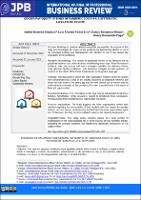| dc.contributor.author | Romero Bendezú, Anibal | |
| dc.contributor.author | Núñez Lira, Luis Alberto | |
| dc.contributor.author | Retamozo Riojas, Danny | |
| dc.contributor.author | Barazorda Puga, Nancy | |
| dc.date.accessioned | 2024-10-31T22:27:22Z | |
| dc.date.available | 2024-10-31T22:27:22Z | |
| dc.date.issued | 2023 | |
| dc.identifier.uri | https://hdl.handle.net/20.500.13067/3455 | |
| dc.description.abstract | Purpose:Building on previous research on gender pay equality, the purpose of this study is to investigate the impact of the pandemic by determining whether or not it has increased existing pay discrepancies and whether or not it has caused pay inequalities in theworkplace.
Research methodology:The method of systematic review of the literature and its guidelines has been used, which includes the following seven steps: Raise the research problems, select the sources and search strategies, establish the selection criteria, study selection, Quality evaluation , data extraction strategies and data synthesis, of research on the effects of the Covid-19 pandemic on the gender wage gap.
Findings:The data analysis shows the main publication medium where the articles were disseminated has a total of ten articles, becoming an important reference and where the main cause of the salary gap was the work carried out by women was the undervaluation compared to that carried out For men, a second factor is the report of fewer job opportunities.
Research limitations:The information in this page may be extrapolated to all of our facilities. Nonetheless, further research is needed to corroborate these conclusions. The data comes from several sources, making bias less likely.
Practical implications:The study suggests that labor organizations review their practices regarding the incorporation of their workers, with due respect for equality between men and women, understanding that both have the same opportunities, rights and, furthermore, that they must be evaluated based on the capacity development.
Originality/Value:This study whose selection criteria of a large number of investigations of the main databases, led us to the analysis of sixty scientific articles, answering the research questions and establishing significant conclusions on the subject matter | es_PE |
| dc.format | application/pdf | es_PE |
| dc.language.iso | eng | es_PE |
| dc.publisher | JPB Review | es_PE |
| dc.rights | info:eu-repo/semantics/openAccess | es_PE |
| dc.rights.uri | https://creativecommons.org/licenses/by-nc/4.0/ | es_PE |
| dc.source | AUTONOMA | es_PE |
| dc.subject | Pandemic | es_PE |
| dc.subject | COVID-19 | es_PE |
| dc.subject | Gender Pay Gap | es_PE |
| dc.subject | Labor Equity | es_PE |
| dc.subject | Systematic Review | es_PE |
| dc.title | Gender Pay Equity In Times Of Pandemic COVID-19: a Systematic Literature Review | es_PE |
| dc.title.alternative | Igualdad salarial entre Hombres y Mujeres en Tiempos De Pandemia COVID-19: Revisión Sistemática De La Bibliografía | es_PE |
| dc.title.alternative | Equidade de Pagamento De Gênero Em Tempos De Pandemia COVID-19: Uma Revisão Sistemática Da Literatura | es_PE |
| dc.type | info:eu-repo/semantics/article | es_PE |
| dc.identifier.journal | International Journal of Professional Business Review | es_PE |
| dc.identifier.doi | https://doi.org/10.26668/businessreview/2023.v8i1.937 | es_PE |
| dc.subject.ocde | https://purl.org/pe-repo/ocde/ford#5.02.04 | es_PE |
| dc.source.volume | 8 | es_PE |
| dc.source.issue | 1 | es_PE |
| dc.source.beginpage | 1 | es_PE |
| dc.source.endpage | 23 | es_PE |


